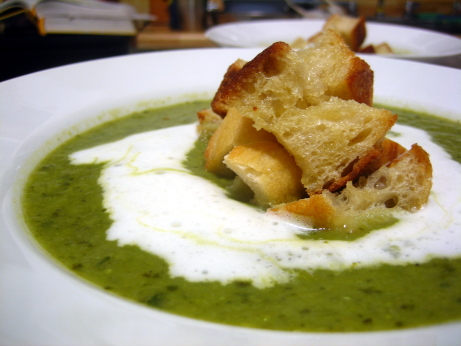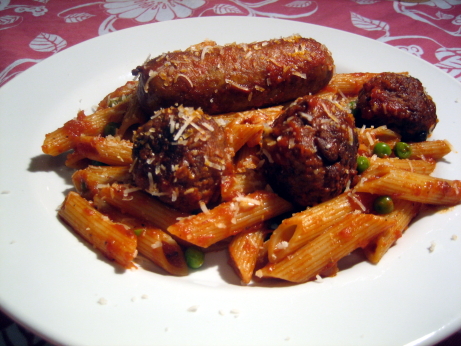I was really excited to try this soup. I went looking for a pea soup recipe in The Book, expecting to find a hearty split pea version with ham hocks, instead I got this spring vegetable centric Potage-Saint-Germain. It wasn’t really what I was looking for that night, and the idea of mint in my soup seemed a bit weird, but one ingredient captured my imagination and I knew I had to do this recipe ASAP. That ingredient was lettuce. I’ve been toying with the idea of cooked lettuce since I saw an early Julia Child episode where she braises whole Romaine heads and serves the flaccid results. It looked terrible but she assured me that it was an excellent treatment for lettuce. As we all know, Julia’s word is law, or at least worthy of a test. I’ve never cooked lettuce in any way before, I guess it’s not that different from cooking bitter greens, bok choy or cabbage, but it seems delightfully sacrilegious and just plain wrong.
To prepare this soup you start by making croûtons with an old baguette, butter and salt in the oven. The soup starts with softening leaks in butter, then adding chicken stock and water. Once it’s boiling you add chopped Bibb lettuce, and frozen peas. As soon as the peas are tender you stir in fresh mint, and purée the soup in the blender (seriously be careful, hot pea soup was used as a viable substitute for napalm in the Nam). The soup is then seasoned with salt and pepper, and served hot topped with croûtons and lightly beaten cream.
The idea with the beaten cream was to make elegant drops, and to run a knife through them to make a stunning pattern. You can see how well that worked out for me. I think my central problem with this soup was that it was served hot. The hot soup melted the slightly whipped cream and sent it running all over the place, and it just tasted weird. Minted things are rarely served piping hot, it’s an odd juxtaposition, mint is the universal symbol of cool and refreshing, but this was a thick, hearty, hot, soup. I tried some the next day at room temperature and I was much happier. The lettuce experiment was a success though, the lettuce along with peas, leaks, and mint were the prominent flavours in the soup, and the lettuce really worked. The Book describes the flavour of the lettuce in this soup as “grassy” and I’m glad they got in a food writing buzz word there, but really it tastes exactly like uncooked lettuce, and in this case that’s a good thing. Again, hot lettuce isn’t really for me, I much preferred that flavour when the soup was cool. I like croûtons in any context, and this was no exception. The soup was thick enough that they floated easily, and didn’t get soggy.
I won’t be rushing to make this soup again, and if I did I certainly wouldn’t serve it warm. The flavours and ideas were pretty good, but the temperature was a big miss, and I wasn’t fond of the drizzled cream on top. I think the ideas behind this soup are solid, and I’m looking forward to playing with different combinations of these ingredients. Pottage-Saint-Germain is a beloved French classic, but I’m not sure it’s for me.

